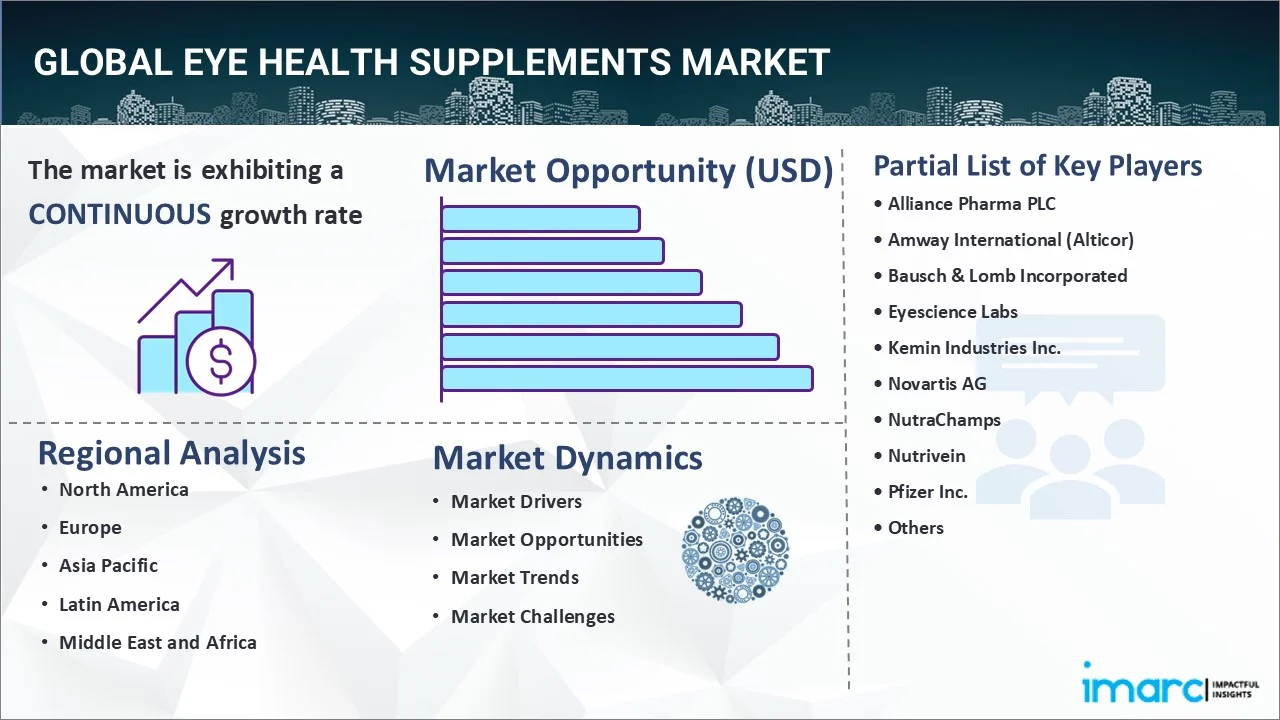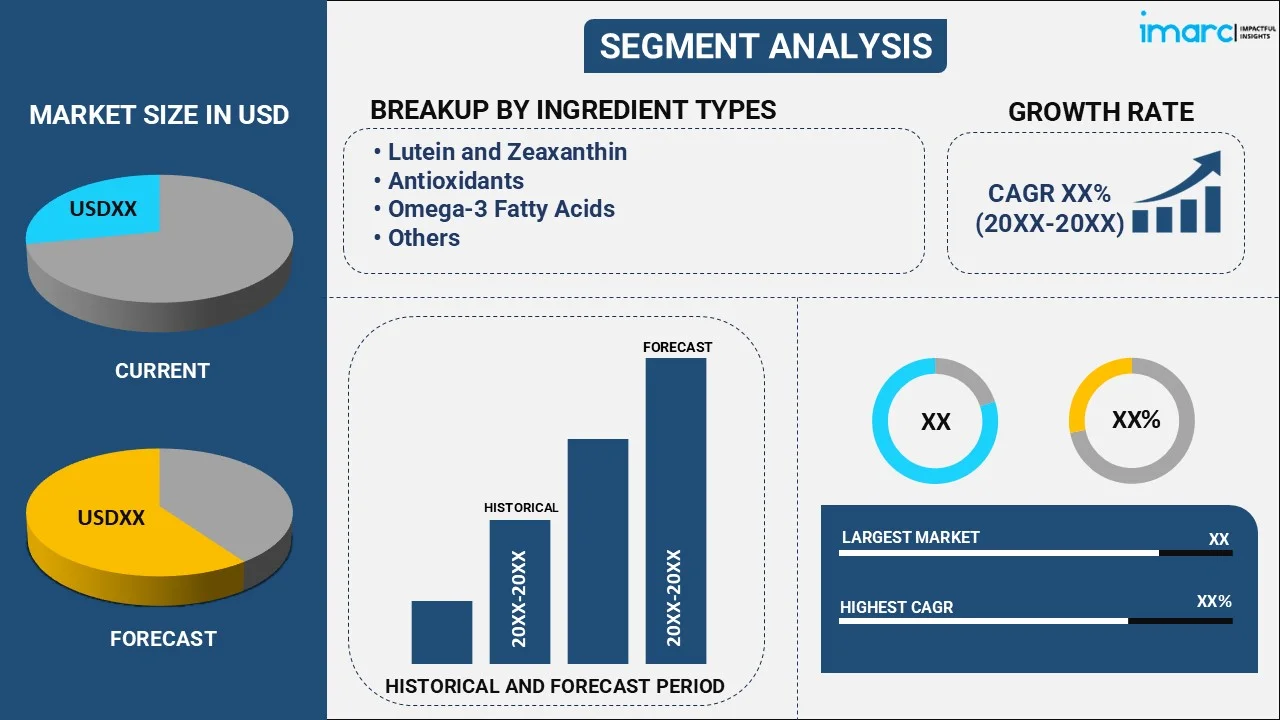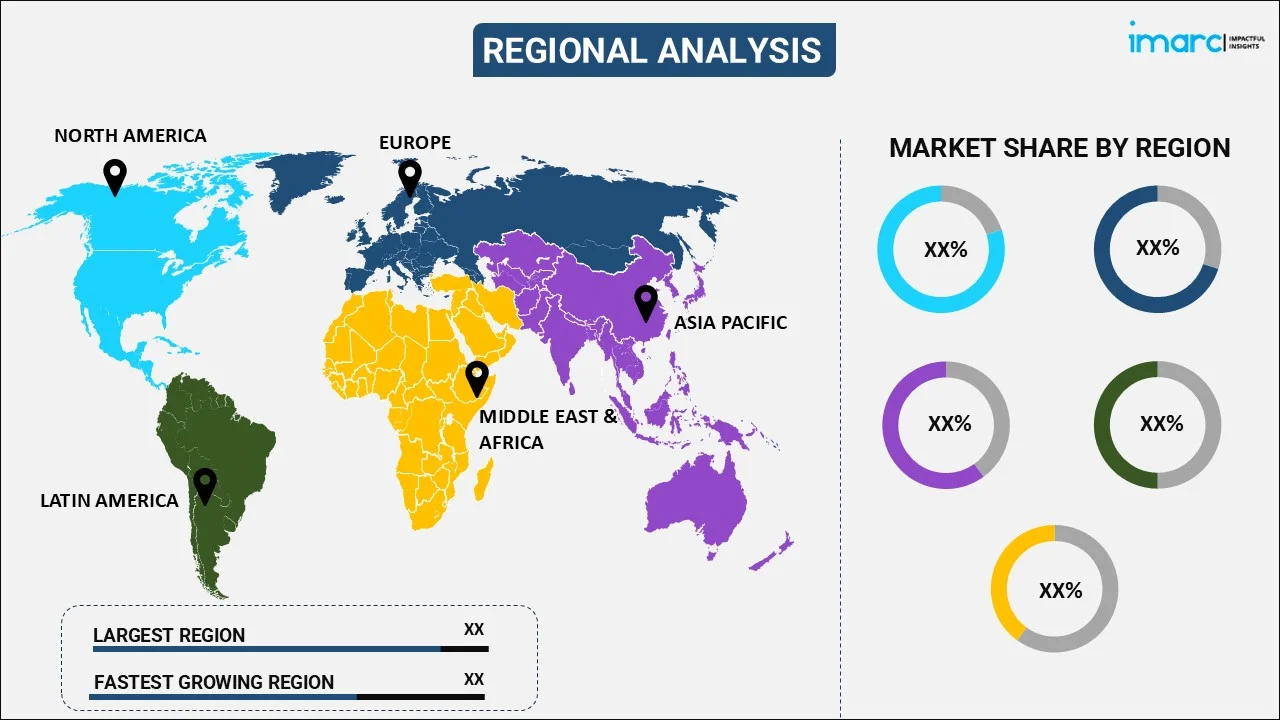
Eye Health Supplements Market Report by Ingredient Type (Lutein and Zeaxanthin, Antioxidants, Omega-3 Fatty Acids, Coenzyme Q10, Flavonoids, Alpha-Lipoic Acid, and Others), Indication (Age-related Macular Degeneration (AMD), Cataract, Dry Eye Syndrome, Inflammation, and Others), Formulation (Tablets, Capsules, Powder, and Others), and Region 2025-2033
Market Overview:
The global eye health supplements market size reached USD 2.2 Billion in 2024. Looking forward, IMARC Group expects the market to reach USD 4.1 Billion by 2033, exhibiting a growth rate (CAGR) of 6.5% during 2025-2033. The increasing number of working professionals and students who rely on smart devices, rising prevalence of ocular disorders, and the growing inclination towards online pharmacy websites and applications are some of the major factors propelling the market.
|
Report Attribute
|
Key Statistics
|
|---|---|
|
Base Year
|
2024 |
|
Forecast Years
|
2025-2033
|
|
Historical Years
|
2019-2024
|
| Market Size in 2024 | USD 2.2 Billion |
| Market Forecast in 2033 | USD 4.1 Billion |
| Market Growth Rate (2025-2033) | 6.5% |
Eye Health Supplements Market Analysis:
- Market Growth and Size: The global eye health supplements market is experiencing moderate growth on account of the increasing prevalence of eye diseases and a growing awareness about eye health.
- Major Market Drivers: Key factors include the increasing digital screen time among all age groups is leading to a higher incidence of digital eye strain, thereby driving the demand for eye health supplements.
- Key Market Trends: There is a notable shift towards the consumption of supplements containing natural and organic ingredients, driven by individual preference for clean-label products.
- Geographical Trends: North America dominates the market, driven by the presence of a well-established healthcare infrastructure and a large aging population. However, Asia Pacific is emerging as a fast-growing market on account of the rising awareness about eye health and improving access to nutritional supplements.
- Competitive Landscape: Key players are investing in marketing and user education campaigns to differentiate their products and establish brand loyalty. Strategic partnerships, mergers, and acquisitions are also common strategies adopted to enhance market presence and expand product portfolios.
- Challenges and Opportunities: Challenges include regulatory scrutiny and the need for scientific validation of health claims. Nonetheless, opportunities for companies to invest in clinical research and develop evidence-based products are projected to overcome these challenges.

Eye Health Supplements Market Trends/Drivers:
Increase in aging population
One of the most significant factors driving the eye health supplements market demand is the growing aging population. As people age, they become more susceptible to eye-related issues such as age-related macular degeneration (AMD), cataracts, and glaucoma. The increasing prevalence of these conditions has created a high demand for preventive healthcare measures, including dietary supplements that can enhance eye health. Many older adults are now opting for eye health supplements as an integral part of their overall wellness strategy.
Rise in screen time
The digital age has significantly increased the amount of time people spend in front of screens. Computers, smartphones, and other digital devices emit blue light, which can contribute to digital eye strain and other vision problems. This has led to a heightened awareness about eye health, thereby boosting the demand for eye supplements that can counteract these effects. Supplements containing ingredients like lutein and zeaxanthin are especially popular, as they are believed to protect the eyes from harmful light rays.
Growing health awareness among the masses
There has been a notable increase in health consciousness among consumers. People are more informed about the importance of preventive healthcare and are willing to invest in it. This mindset has extended to eye care, where the focus is shifting from treating eye problems to preventing them. The growing availability of research and educational materials on the benefits of eye health supplements has made it easier for consumers to make informed choices, further driving the demand for these products. The eye health supplements market outlook remains positive, propelled by rising health consciousness and a shift towards preventive eye care.
Eye Health Supplements Industry Segmentation:
IMARC Group provides an analysis of the key trends in each segment of the global eye health supplements market report, along with forecasts at the global, regional, and country levels for 2025-2033. Our report has categorized the market based on ingredient type, indication, and formulation.
Breakup by Ingredient Type:

- Lutein and Zeaxanthin
- Antioxidants
- Omega-3 Fatty Acids
- Coenzyme Q10
- Flavonoids
- Alpha-Lipoic Acid
- Others
Lutein and zeaxanthin dominate the market
The report has provided a detailed breakup and analysis of the market based on the ingredient type. This includes lutein and zeaxanthin, antioxidants, omega-3 fatty acids, coenzyme Q10, flavonoids, alpha-lipoic acid and others. According to the report, lutein and zeaxanthin represented the largest segment. Lutein and zeaxanthin are carotenoids naturally found in the human eye, specifically in the retina and the macula. They are also present in various foods like green leafy vegetables and colorful fruits. Lutein and zeaxanthin are believed to protect the eyes by absorbing harmful high-energy light waves like ultraviolet rays. They enhance the density of the macular pigment, which effectively serves as a protective layer that shields the retina from damage.
Antioxidants fight against oxidative stress, which is a key factor in the degeneration of eye tissues. Vitamin C supports the health of blood vessels in the eyes and is found in high concentrations in various eye tissues. Vitamin E protects cells in the eyes from unstable molecules called free radicals, which can break down healthy tissue. Zinc is essential for maintaining the health of the retina and can play a role in protecting against AMD and cataracts.
Breakup by Indication:
- Age-related Macular Degeneration (AMD)
- Cataract
- Dry Eye Syndrome
- Inflammation
- Others
Age-related macular degeneration (AMD) holds the largest share in the market
A detailed breakup and analysis of the market based on the indication has also been provided in the report. This includes age-related macular degeneration (AMD), cataract, dry eye syndrome, inflammation and others. According to the report, age-related macular degeneration (AMD) accounted for the largest market share. AMD is a common eye condition that affects the central vision, which leads to blindness in severe cases. It primarily impacts people over the age of 50. Supplements containing lutein and zeaxanthin, and antioxidants like vitamin C, vitamin E, and zinc, are often indicated for those at risk of AMD. These nutrients are believed to improve the density of the macular pigment, which provides a protective layer that can slow the progression of AMD.
A cataract is a clouding of the natural lens of the eyes, which can cause vision loss over time. Antioxidant vitamins like Vitamin C and Vitamin E are often indicated for cataract prevention. These antioxidants help protect the lens of the eyes from oxidative damage that can lead to clouding.
Breakup by Formulation:
- Tablets
- Capsules
- Powder
- Others
Tablets dominate the market
The report has provided a detailed breakup and analysis of the market based on the formulation. This includes tablets, capsules, powder, and others. According to the report, tablets represented the largest segment. Eye health supplements in tablet form are compressed powders that contain the necessary vitamins, minerals, and carotenoids beneficial for eye health. Tablets are generally easy to store and have a longer shelf life. They can also incorporate a higher concentration of ingredients and are usually more cost-effective.
Capsules consist of a shell, usually made from gelatin or a vegetarian substitute, which encases the supplement ingredients in powder or liquid form. Capsules are often easier to swallow than tablets and may be more quickly absorbed in the digestive system. They are also less likely to contain binders and fillers, making them a cleaner option for some.
Breakup by Region:

- North America
- United States
- Canada
- Asia Pacific
- China
- Japan
- India
- South Korea
- Australia
- Indonesia
- Others
- Europe
- Germany
- France
- United Kingdom
- Italy
- Spain
- Russia
- Others
- Latin America
- Brazil
- Mexico
- Others
- Middle East and Africa
North America exhibits a clear dominance, accounting for the largest eye health supplements market share
The market research report has also provided a comprehensive analysis of all the major regional markets, which include North America (the United States and Canada); Asia Pacific (China, Japan, India, South Korea, Australia, Indonesia, and others); Europe (Germany, France, the United Kingdom, Italy, Spain, Russia, and others); Latin America (Brazil, Mexico, and others); and the Middle East and Africa. According to the report, North America accounted for the largest market share.
The increasing awareness about the benefits of consuming eye health supplements among the masses represents one of the primary factors bolstering the eye health supplements market growth in the North America region. Moreover, rising levels of air pollution is contributing to the market growth in the region. Besides this, the growing influence of social media platforms is influencing the market positively.
Competitive Landscape:
The leading companies are using nano encapsulation technology to improve the bioavailability of key ingredients like lutein and zeaxanthin and the body can absorb them more efficiently by encapsulating these nutrients at the nanoscale, thereby enhancing their effectiveness in supporting eye health. They are also utilizing genetic testing that can identify individual predispositions to certain eye conditions, which allows for personalized supplement formulations that specifically target those conditions. Moreover, key players are incorporating artificial intelligence (AI) and machine learning (ML) that can analyze large data sets from scientific studies to identify the most beneficial combinations of nutrients for eye health.
The report has provided a comprehensive analysis of the competitive landscape in the market. Detailed profiles of all major companies have also been provided. Some of the key players in the market include:
- Alliance Pharma PLC
- Amway International (Alticor)
- Bausch & Lomb Incorporated
- Eyescience Labs
- Kemin Industries Inc.
- Novartis AG
- NutraChamps
- Nutrivein
- Pfizer Inc.
- The Nature's Bounty Co.
- Vitabiotics Ltd.
- ZeaVision LLC
Recent Developments:
- In 2022, Amway International (Alticor) developed nutrition eye supplements in gummies and jelly strips containing lutein and zeaxanthin to support eye health.
- In 2021, Kemin Industries Inc. acquired Proteus Industries, Inc. to add sustainable clean label yield enhancement technology and expand their product portfolio.
Eye Health Supplements Market Report Scope:
| Report Features | Details |
|---|---|
| Base Year of the Analysis | 2024 |
| Historical Period | 2019-2024 |
| Forecast Period | 2025-2033 |
| Units | Billion USD |
| Scope of the Report | Exploration of Historical Trends and Market Outlook, Industry Catalysts and Challenges, Segment-Wise Historical and Predictive Market Assessment:
|
| Ingredient Types Covered | Lutein and Zeaxanthin, Antioxidants, Omega-3 Fatty Acids, Coenzyme Q10, Flavonoids, Alpha-Lipoic Acid, Others |
| Indications Covered | Age-Related Macular Degeneration (AMD), Cataract, Dry Eye Syndrome, Inflammation, Others |
| Formulations Covered | Tablets, Capsules, Powder, Others |
| Regions Covered | North America, Asia Pacific, Europe, Latin America, Middle East and Africa |
| Countries Covered | United States, Canada, China, Japan, India, South Korea, Australia, Indonesia, Germany, France, United Kingdom, Italy, Spain, Russia, Brazil, Mexico |
| Companies Covered | Alliance Pharma PLC, Amway International (Alticor), Bausch & Lomb Incorporated, Eyescience Labs, Kemin Industries Inc., Novartis AG, NutraChamps, Nutrivein, Pfizer Inc., The Nature's Bounty Co., Vitabiotics Ltd., ZeaVision LLC, etc. |
| Customization Scope | 10% Free Customization |
| Post-Sale Analyst Support | 10-12 Weeks |
| Delivery Format | PDF and Excel through Email (We can also provide the editable version of the report in PPT/Word format on special request) |
Key Benefits for Stakeholders:
- IMARC’s industry report offers a comprehensive quantitative analysis of various market segments, historical and current market trends, market forecasts, and dynamics of the eye health supplements market from 2019-2033.
- The research report provides the latest information on the market drivers, challenges, and opportunities in the global eye health supplements market.
- The study maps the leading, as well as the fastest-growing, regional markets. It further enables stakeholders to identify the key country-level markets within each region.
- Porter's five forces analysis assist stakeholders in assessing the impact of new entrants, competitive rivalry, supplier power, buyer power, and the threat of substitution. It helps stakeholders to analyze the level of competition within the eye health supplements industry and its attractiveness.
- Competitive landscape allows stakeholders to understand their competitive environment and provides an insight into the current positions of key players in the market.
Key Questions Answered in This Report
We expect the global eye health supplements market to exhibit a CAGR of 6.5% during 2025-2033.
The growing cases of ocular disorders specifically among the geriatric population, coupled with the increasing consumer awareness towards the availability of various eye health supplements that aid in proper visual and retinal function, are primarily driving the global eye health supplements market.
The sudden outbreak of the COVID-19 pandemic has led to the rising demand for eye health
supplements on account of the prolonged exposure to computers, phones, and tablets during remote working models and online classes.
Based on the ingredient type, the global eye health supplements market can be segmented into lutein and zeaxanthin, antioxidants, omega-3 fatty acids, coenzyme Q10, flavonoids, alpha-lipoic acid, and others. Currently, the lutein and zeaxanthin segment holds the majority of the total market share.
Based on the indication, the global eye health supplements market has been divided into Age-related Macular Degeneration (AMD), cataract, dry eye syndrome, inflammation, and others. Among these, Age- related Macular Degeneration (AMD) exhibits a clear dominance in the market.
Based on the formulation, the global eye health supplements market can be categorized into tablets, capsules, powder, and others. Currently, tablets account for the largest market share.
On a regional level, the market has been classified into North America, Asia-Pacific, Europe, Latin America, and Middle East and Africa, where North America currently dominates the global market.
Some of the major players in the global eye health supplements market include Alliance Pharma PLC, Amway International (Alticor), Bausch & Lomb Incorporated, Eyescience Labs, Kemin Industries Inc., Novartis AG, NutraChamps, Nutrivein, Pfizer Inc., The Nature's Bounty Co., Vitabiotics Ltd. and ZeaVision LLC.
Need more help?
- Speak to our experienced analysts for insights on the current market scenarios.
- Include additional segments and countries to customize the report as per your requirement.
- Gain an unparalleled competitive advantage in your domain by understanding how to utilize the report and positively impacting your operations and revenue.
- For further assistance, please connect with our analysts.
 Request Customization
Request Customization
 Speak to an Analyst
Speak to an Analyst
 Request Brochure
Request Brochure
 Inquire Before Buying
Inquire Before Buying




.webp)




.webp)












